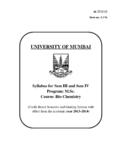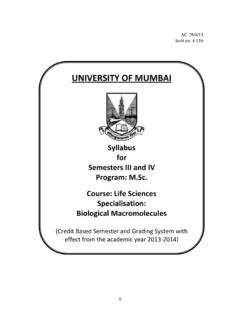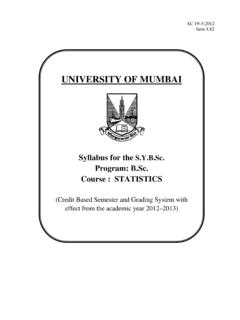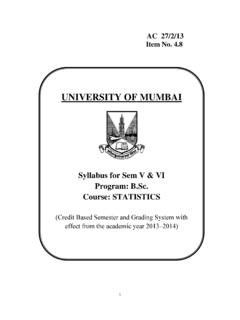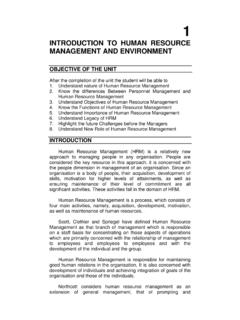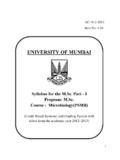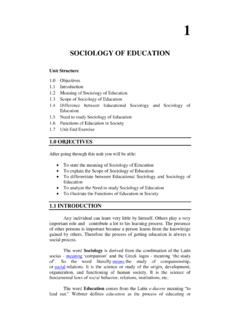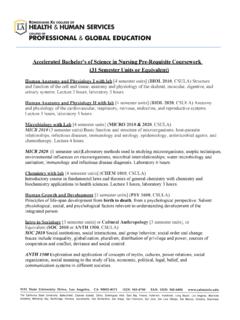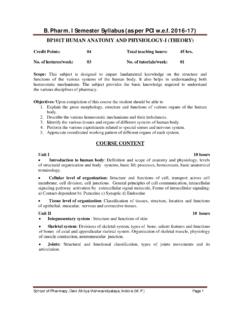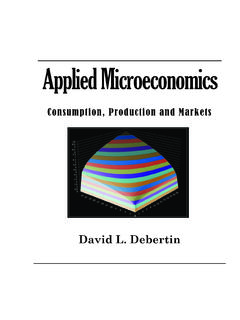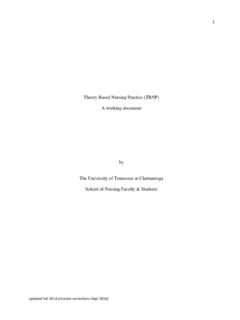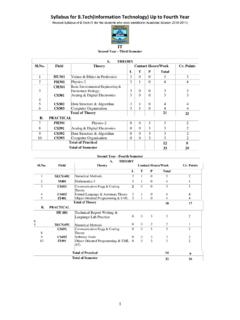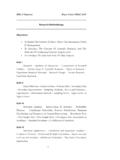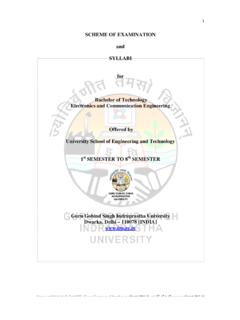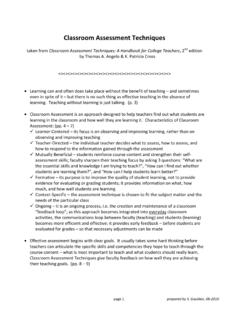Transcription of UNIVERSITY OF MUMBAI
1 AC 27/2/13. Item no. UNIVERSITY OF MUMBAI . Syllabus for sem V & VI. Programme: B. Sc. Course - Information Technology (as per Credit Based semester and Grading System Academic Year 2013 14). 1. semester V. Courses and Course Codes semester V. Course Code Course Title Course Code Course Title Network Security USIT501 Network Security USIT5P1 practical With C#. USIT502 With C# USIT5P2 practical Software Testing USIT503 Software Testing USIT5P3 practical Advanced Java USIT504 Advanced Java USIT5P4 practical Linux Administration USIT505 Linux Administration USIT5P5 practical semester VI. Course Code Course Title Course Code Course Title USIT601 Internet Technology USIT6P1 Internet Technology practical Project Management Case USIT602 Project Management USIT6P2 Studies USIT603 Data Warehousing USIT6P3 Data Warehousing practical USIT607 Project Report USIT608 Project Viva Voce Elective IPR and Cyber Laws Case USIT604 IPR and Cyber Laws USIT6P4 Studies Digital Signal And Systems USIT605 Digital Signal And Systems USIT6P5 practical Geographic Information Geographic Information USIT606 USIT6P6 Systems Systems practical 2.
2 semester V. PROGRAMME: B. Sc (Information Technology) semester V. COURSE: NETWORK SECURITY COURSE CODE: USIT501. Periods per week Lecture 5. 1 Period is 50 minutes practical 3. Hours Marks Evaluation System Theory Examination 2 60. Theory Internal -- 40. practical 50. Unit I Computer Security : Introduction, Need for security, Principles of Security, 10. Types of Attacks Lectures Cryptography : Plain text and Cipher Text, Substitution techniques, Caesar Cipher, Mono-alphabetic Cipher, Polygram, Polyalphabetic Substitution, Playfair, Hill Cipher, Transposition techniques, Encryption and Decryption, Symmetric and Asymmetric Key Cryptography, Steganography, Key Range and Key Size, Possible Types of Attacks Unit II : Symmetric Key Algorithms and AES: Algorithms types and modes, Overview 10.
3 Of Symmetric key Cryptography, Data Encryption Standard (DES), International Lectures Data Encryption Algorithm (IDEA), RC4, RC5, Blowfish, Advanced Encryption Standard (AES). Unit III Asymmetric Key Algorithms, Digital Signatures and RSA: Brief history of 10. Asymmetric Key Cryptography, Overview of Asymmetric Key Cryptography, Lectures RSA algorithm, Symmetric and Asymmetric key cryptography together, Digital Signatures, Knapsack Algorithm, Some other algorithms (Elliptic curve cryptography, ElGamal, problems with the public key exchange). Unit IV Digital Certificates and Public Key Infrastructure (PKI): Digital Certificates, 10. Private Key Management, The PKIX Model, Public Key Cryptography Lectures Standards (PKCS), XML,PKI and Security, Hash functions, Key Predistribution, Blom's Scheme, Diffie-Hellman Key Predistribution, Kerberos, Diffie-Hellman Key Exchange, The Station-to-station Protocol Unit V Network Security, Firewalls and Virtual Private Networks: Brief 10.
4 Introduction to TCP/IP, Firewalls, IP Security, Virtual Private Networks (VPN), Lectures Intrusion Internet Security Protocols: Basic concepts, Secure Socket Layer (SSL), Transport Layer Security (TLS), Secure Hyper Text Transfer Protocol (SHTTP), Time Stamping Protocol (TSP), Secure Electronic Transaction (SET), SSL vs SET, 3-D Secure Protocol, Electronic Money, E-mail Security, Wireless Application Protocol (WAP) Security, Security in GSM, Security in 3G. Unit VI User Authentication and Kerberos: Authentication basics, Passwords, 10. Authentication Tokens, Certificate-based Authentication, Biometric Lectures Authentication, Kerberos, Key Distribution Center (KDC) , Security Handshake Pitfalls, Single Sign On (SSO) Approaches Books: Cryptography and Network Security by Atul Kahate, 2nd Edition, Tata McGrawHill (Unit I: Chapter 1,2, Unit II: Chapter 3, Unit III: Chapter 4, Unit IV: Chapter 5, Unit V: Chapter 6, Unit VI: Chapter 7).
5 References: Cryptography and Network Security by William Stallings, Fifth Edition, Pearson Education. Cryptography: Theory and Practice by Douglas Stinson, CRC Press, CRC Press LLC. 3. Course Code : USIT5P1. Practicals: 1. Implementing Substitution Ciphers a. Caesar Cipher b. Modified Caesar Cipher c. Mono-Alphabetic d. Poly-Alphabetic 2. Implementing Transposition Ciphers a. Rail fence Techniques b. Simple Columnar c. Multicolumnar d. Vernam Cipher 3. Implementing Diffie Helman Key Exchange Algorithm 4. Implementing DES Algorithm 5. Implementing IDEA. 6. Implementing AES. 7. Implementing RSA Algorithm 8. Implementing RC4, RC5. 9. Implementing Blowfish 4. PROGRAMME : B. Sc (Information Technology) semester V.
6 COURSE: with C# (COURSE CODE USIT502). Periods per week Lecture 5. 1 Period is 50 minutes practical 3. Hours Marks Evaluation System Theory Examination 2 60. Theory Internal -- 40. practical 50. Unit-I Review of .NET frameworks, Introduction to C#, Variables and expressions, 10. flow controls, functions, debugging and error handling, OOPs with C#, Lectures Defining classes and class members. Unit-II Assembly, Components of Assembly, Private and Shared Assembly, Garbage 10. Collector, JIT compiler. Namespaces Collections, Delegates and Events. Lectures Introduction to 4: framework, lifecycle. CSS: Need of CSS, Introduction to CSS, Working with CSS with visual developer. Unit-III server controls: Introduction, How to work with button controls, 10.
7 Textboxes, Labels, checkboxes and radio buttons, list controls and other web Lectures server controls, and files. Programming web pages: Introduction, data types and variables, statements, organizing code, object oriented basics. Unit-IV Validation Control: Introduction, basic validation controls, validation 10. techniques, using advanced validation controls. Lectures State Management: Using view state, using session state, using application state, using cookies and URL encoding. Master Pages: Creating master pages, content pages, nesting master pages, accessing master page controls from a content page. Navigation: Introduction to use the site navigation, using site navigation controls. Unit-V Databases: Introduction, using SQL data sources, GridView Control, 10.
8 DetailsView and FormView Controls, ListView and DataPager controls, Using Lectures object datasources. Security: Authentication, Authorization, Impersonation, provider model Unit-VI LINQ: Operators, implementations, LINQ to objects,XML, , Query 10. Syntax. Lectures Ajax: Introducing AJAX, Working of AJAX, Using AJAX server controls. JQuery: Introduction to JQuery, JQuery UI Library, Working of JQuery Books: Beginning Visual C# 2010, K. Watson, C. Nagel, Padderson, Reid, , Wrox (Wiley) 2010. (Unit I: Chapter 1 to 10, Unit II: Chapter 11, 13). Murach's 4 Web Programming with C# 2010, 4th Edition, Anne Boehm, Joel Murach, SPD. (Unit III: Chapter 6 Unit IV: Chapter 7,8,9,10 Unit V: Chapter 12,13,14,15,16,17,19,20 Unit VI: Chapter 21).
9 Beginning 4 in C# and VB, I. Spanjaars, Reprint 2011. (Unit II: Chapter 2 and 3 Unit III: Chapter 5 Unit VI: Chapter 14). 5. References: programming, J. Kanjilal, Tata McGraw-Hill. Programming , , Microsoft Press (Dreamtech), Reprint 2011. Visual C#.NET, Vijay Nicoel, TMH. Course Code : USIT5P2. practical : 1. Simple Programs with C#: a) Write a console application that obtains four int values from the user and displays the product. Hint: you may recall that the () command was used to convert the input from the console to a double; the equivalent command to convert from a string to an int is (). b) If you have two integers stored in variables var1 and var2, what Boolean test can you perform to see if one or the other (but not both) is greater than 10?
10 C) Write an application that includes the logic from Exercise 1, obtains two numbers from the user, and displays them, but rejects any input where both numbers are greater than 10 and asks for two new numbers. d) Write a console application that places double quotation marks around each word in a string e) Write an application that uses two command-line arguments to place values into a string and an integer variable, respectively. Then display these values. f) Write an application that receives the following information from a set of students: Student Id: Student Name: Course Name: Date of Birth: The application should also display the information of all the students once the data is entered. Implement this using an Array of Structs.
